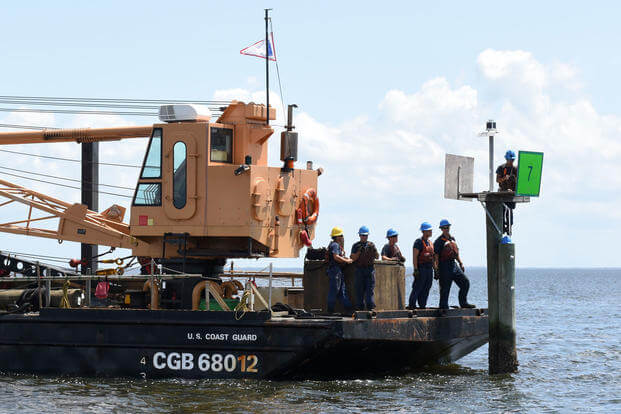INCHEON, South Korea -- As the 2018 hurricane season opens, the international maritime community recognized the Coast Guard for its efforts last year to restore safe marine navigation in waterways hit by hurricanes Harvey, Irma and Maria.
The members of the International Association of Marine Aids to Navigation and Lighthouse Authorities selected the Coast Guard for its best practices award during its quadrennial conference, held here May 27-June 2.
A leader in the employment of electronic aids to navigation, the Coast Guard maintains more than a quarter of the eATON in use around the world today.
Using the Nationwide Automatic Identification System network of shore-based towers, the service employs eATON to augment its constellation of physical aids to navigation for mariners who can "see" eATON with an AIS receiver and electronic charting system or integrated radar.
Besides hurricane preparation and response, eATON has also been successfully used to respond to high-water events in the West and to supplement buoys in ice-covered waterways.
Hurricane Response
Following Hurricane Harvey, the Coast Guard established 13 eATON around Port Aransas, Texas. By temporarily using eATON to mark the buoys and beacons that were destroyed or damaged by the hurricane, the Coast Guard was able to reopen the port more quickly.
Leveraging the lessons learned from Hurricane Harvey to prepare for Hurricane Irma, the Coast Guard proactively established 301 eATON locations around U.S. waterways that were predicted to lie in the storm's track. The eATON marked waterways from Tampa, Florida, to Key West, Florida, and up the eastern seaboard to Charleston, South Carolina, as well as around Puerto Rico.
Following the hurricanes, eATON provided a constant aid to navigation for mariners, including the buoy tenders and ATON teams that reconstituted the damaged physical ATON system.
International Recognition
Based in Saint Germain-en-Laye, France, IALA is no-profit, international technical association that brings together Aids to Navigation authorities from 80 nations, as well as numerous industrial members who provide ATON services or technical advice.
During the IALA Conference's general assembly, the United States was re-elected to the IALA Council, which is IALA's governing body and responsible for approval of all IALA guidelines and recommendations.
"It is an honor and privilege to be a part of the leadership team that will lead IALA into the future," said Coast Guard Capt. Mary Ellen Durley, chief of the Office of Navigation Systems and the designated U.S. councilor to IALA. "The maritime industry is going through a stage of rapid technological advances, and I look forward to IALA addressing these challenges over the next four year work plan."
Coast Guard ATON personnel serve on IALA committees and contribute to the organization's aim to ensure that seafarers are provided with effective and harmonized aids to navigation services worldwide to assist in the safe navigation of shipping and protection of the environment.
In addition to making presentations and chairing various panels, members from the U.S. delegation were also appointed to positions on IALA's e-Navigation Committee and Aids to Navigation Requirements and Management Committee.
"I was very impressed with the openness of all delegations working together to share their technical knowledge and collectively advance safety and the future of navigation," said Coast Guard Capt. Kevin C. Kiefer, the deputy director of the U.S. Marine Transportation System Directorate, which oversees the Coast Guard's navigation systems, waterways management, bridges and Arctic policy programs. "The U.S. Coast Guard continues to play a major role in developing and supporting these international efforts."















